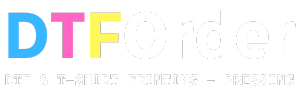Direct-to-Film (DTF) printing technology is rapidly emerging as a popular choice for showcasing individual styles and expanding product ranges. This technology stands out for its versatility, allowing for printing on a diverse array of fabric types. DTF printing is renowned for its advanced system and cost-effectiveness, offering a more technologically refined alternative to traditional screen printing while maintaining comparable quality.
In contrast to sublimation printing, which is limited to polyester fabrics, DTF transfer breaks free from these constraints. It offers the flexibility to print on any fabric type and color, eliminating the need to restrict designs to white fabrics. This opens up a world of possibilities, allowing you to actualize any envisioned design on the fabric of your choice.
DTF printing empowers you to bring your creative designs to life with ease. While the initial learning phase might appear daunting, the process is surprisingly straightforward. DTF transfers, tailored specifically for your needs, can even be applied at home with simple tools like an iron providing the necessary heat. This accessibility and simplicity make DTF printing an attractive option for both professional and personal printing projects.
Stages of DTF Printing Process:
- Design Digitization: The inception of the DTF printing process involves converting the intended design into a digital format. Utilizing Computer-Aided Design (CAD) software, the design is either crafted or digitized, with specific attention to color, pattern, and size specifications.
- Ink Transfer onto Film: The digitally prepared design is then printed onto a specialized DTF transfer film. This film serves as a carrier, effectively transporting the design from the digital realm to a physical medium.
- Fabric Application: The next step involves transferring the design from the film to the fabric. This is achieved through the application of heat and pressure, ensuring that the ink from the transfer film is thoroughly transferred and adhered to the fabric.
- Ink Fixation and Drying: Post-transfer, the ink undergoes a fixation process. Here, heat and pressure are applied to enable the ink to deeply penetrate the fabric, thus becoming permanent. Following this, the print is solidified and set through a drying process.
- Final Touches and Finishing: After the printing process, the fabric can undergo various finishing procedures. These may include cutting, stitching, or adding further design elements to enhance the final product.
Advantages of DTF Printing in Textile Industry:
The DTF printing system is extensively utilized in the textile industry, known for customizing a variety of products while delivering high-quality prints. This technology stands out for its accelerated production capabilities, minimal waste production, and expansive range of design possibilities. It offers immense flexibility for designers and manufacturers, especially in executing complex designs with color gradients and intricate patterns. This versatility and efficiency make DTF printing a preferred choice in the modern textile industry for a diverse array of applications.
White Ink Management in DTF Printing:
In the Direct to Film (DTF) printing process, white ink circulation is a crucial component. This process entails the continuous agitation and mixing of white ink within the printer. Such a practice is essential to prevent the ink from settling and causing nozzle blockages, thereby maintaining a consistently high print quality. The role of white ink is particularly significant in establishing the base color or patterns on textile products. Due to its denser and thicker consistency compared to other inks, white ink demands careful handling and management. Ensuring effective circulation of this ink is pivotal, as the quality of prints not only enhances the visual appeal but also ensures the durability of the printed products.
Maintenance and Cleaning of DTF Print Transfer Ink:
Regular maintenance and cleaning are imperative for the optimal functioning of a DTF printing system, which is subject to continuous operational pressures. Adequate cleaning is essential to prevent color discrepancies in subsequent prints. Fortunately, this maintenance procedure is neither complicated nor time-consuming.
The ink cleaning process plays a critical role in sustaining the proper functioning of the DTF printing system and in preserving the quality of prints. Regular upkeep and cleaning are instrumental in extending the lifespan of the printing system. They are key to minimizing occurrences of ink blockages and operational issues. Utilizing cleaning liquids, which can be easily prepared, is an effective way to maintain the system. Adhering to a routine cleaning schedule ensures the continued efficiency and reliability of the DTF printing process, contributing significantly to the overall success of the printing operations.

